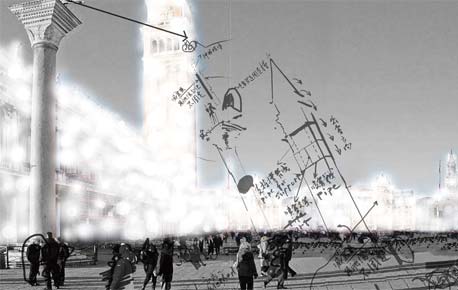 |
||||
|
||||
|
||||
ARTEXT : La Biennale di Venezia
PERVASION
"Your pavilion conception Pervasion explains art in terms of beaty and then treats beaty in terms of flavors or smells-senses that the Western tradition considers least aesthetically valid because the least cognitive and clear. Yes. My proposal represents a Chinese perspective, but Western perspectives helped me find it. Body consciousness played an important role in traditional Chinese art and aesthetics, but I did not think much of it until I encountered your somaesthetics. Western affect theory also is useful for understanding our installations. How did you choose the artists? Besides issues of diversity in age, gender, and status, I wanted artists who never before exhibited at this Biennale and could produce distinctive, beatiful flavors. (The five selected Yuan Gong, Pan Gongkai, Liang Yuanwei, Yang Maoyuan, Cai Zhisong) P.F. - What type of work is this? It is difficult to classify it with our existing categories. It does not hold a form or boundaries, appearing intermittently… perhaps you may call it an art installation, land art, environmental art, performance art, any one of these categories may only represent one of its aspects while covering the others features. It expands, pervades into time and space, physically and psychologically. It belittles boundaries, disrupts order, making order fall into chaos, the formless as form. Yuan Gong has wished to make St Marco Square disappear using this approach, which turns into his artwork. However, his wish can’t be realized thus far. Some associates his idea with Jean Claude & Chrtisto’s installation or land art. Although, I would like to point out that, they are different both in form and concept. Jean Claude & Christo focus on the visual and surface effect of their work, whereas Yuan Gong’s art opens all of our senses, it’s not only visible, but also audible,sensible, tasteful and tangible. Jean Claude & Christo’s works have form where as Yuan Gong’s transforms in an in-between existence.Wrapping transforms one form into the other. Yet, it is incapable to make an object formless. Yuan gong’s annotation on the relationship of existence seems ingenious, diverse and in-depth. Unlike the representation of emptiness in a void space, Yuan Gong instead fills the void, presenting emptiness by occupying it. Where there is emptiness there is Yuan Gong’s work, in fact that’s how emptiness will be experienced. Yuan gong’s work successfully appropriates the Daoist thoughts on emptiness and the enlightenment As we see the mist, listening to music and smelling the scent of sandalwood, sensing the fresh and moist mist, we have enter Yuan Gong’s world; however, perhaps a more realistic sense is Yuan Gong’s art has entered our world, not only has it permeated through our sense, but also into our bodies. Effacing the distance between time and space and the boundary between the world and ourselves, Yuan Gong’s artwork throws this befuddling concept unreservedly to all our senses, making the unseen perceivable of in-between existences.
Curatori - Peng Feng Artisti : Yuan Gong, Pan Gongkai, Liang Yuanwei, Yang Maoyuan, Cai Zhisong,
Web site: http://www.labiennale.org |
||||
Artext © 2011 |
